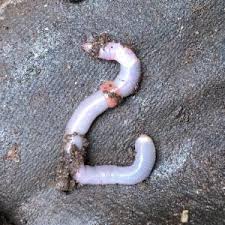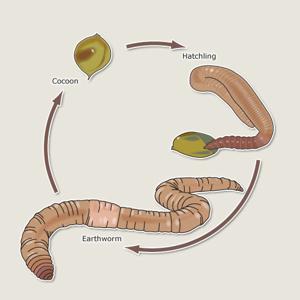Octolasion cyaneum: Difference between revisions
No edit summary |
|||
| Line 38: | Line 38: | ||
==Life Cycle== | ==Life Cycle== | ||
[[File:Octo_Life_cycle.jpg|600px|thumb|left|Octolasion cyaneum life cycle]] | [[File:Octo_Life_cycle.jpg|600px|thumb|left|Octolasion cyaneum life cycle </ref> <ref name= "Bobbie">Bobbie Kalman, The life cycle of an earthworm. New York: Crabtree, 2004 </ref>.]] | ||
''O. cyaneum'' are hermaphrodites, possessing both male and female reproductive organs <ref name= “Bendle”>Bendle, P. 2015. Octolasion cyaneum (Common earthworm). Phil Bendle Collection: Worms (Common). CitSciHub. https://citscihub.nz/Phil_Bendle_Collection:Worms_(Common)_Octolasion_cyaneum </ref>. The common mode of reproduction is parthenogenesis that results in the production of genetically homogeneous clones in populations founded on one or only few individuals <ref name= “Lowe”>Lowe, C. N., and K. R. Butt. 2008. Life cycle traits of the parthenogenetic earthworm Octolasion cyaneum (Savigny, 1826). European Journal of Soil Biology 44:541–544. https://doi.org/10.1016/j.ejsobi.2008.08.002 </ref>. They produce either one hatching (singleton) or two hatchings (twins) per cocoon, which are rare but not impossible <ref name= “Lowe”>Lowe, C. N., and K. R. Butt. 2008. Life cycle traits of the parthenogenetic earthworm Octolasion cyaneum (Savigny, 1826). European Journal of Soil Biology 44:541–544. https://doi.org/10.1016/j.ejsobi.2008.08.002 </ref>. The mature ''O. cyaneum'' display a citellum on the front portion of the body that is used for reproduction <ref name= “Bendle”>Bendle, P. 2015. Octolasion cyaneum (Common earthworm). Phil Bendle Collection: Worms (Common). CitSciHub. https://citscihub.nz/Phil_Bendle_Collection:Worms_(Common)_Octolasion_cyaneum </ref>. ''O. cyaneum'' prefer environments that have high values of [[porosity]] and C content, soils with a pH of 5.5-8, and moist soil for development, buckwheat [[rhizosphere]] being the best <ref name= “Kliszcz”>Kliszcz, A., and J. Puła. 2020. The change of pH value and Octolasion cyaneum Savigny earthworms’ activity under stubble crops after spring triticale continuous cultivation. Soil Systems 4(3):39. https://doi.org/10.3390/soilsystems4030039 </ref> <ref name= “Muslim”>Muslim, T. M. 2024. Morphological and environmental conditions of new record [[earthworm]] Octolasion cyaneum in Al-Diwaniyah City/Iraq. Asian Journal of Biological Sciences 17:582–586. https://doi.org/10.3923/ajbs.2024.582.586 </ref>. | ''O. cyaneum'' are hermaphrodites, possessing both male and female reproductive organs <ref name= “Bendle”>Bendle, P. 2015. Octolasion cyaneum (Common earthworm). Phil Bendle Collection: Worms (Common). CitSciHub. https://citscihub.nz/Phil_Bendle_Collection:Worms_(Common)_Octolasion_cyaneum </ref>. The common mode of reproduction is parthenogenesis that results in the production of genetically homogeneous clones in populations founded on one or only few individuals <ref name= “Lowe”>Lowe, C. N., and K. R. Butt. 2008. Life cycle traits of the parthenogenetic earthworm Octolasion cyaneum (Savigny, 1826). European Journal of Soil Biology 44:541–544. https://doi.org/10.1016/j.ejsobi.2008.08.002 </ref>. They produce either one hatching (singleton) or two hatchings (twins) per cocoon, which are rare but not impossible <ref name= “Lowe”>Lowe, C. N., and K. R. Butt. 2008. Life cycle traits of the parthenogenetic earthworm Octolasion cyaneum (Savigny, 1826). European Journal of Soil Biology 44:541–544. https://doi.org/10.1016/j.ejsobi.2008.08.002 </ref>. The mature ''O. cyaneum'' display a citellum on the front portion of the body that is used for reproduction <ref name= “Bendle”>Bendle, P. 2015. Octolasion cyaneum (Common earthworm). Phil Bendle Collection: Worms (Common). CitSciHub. https://citscihub.nz/Phil_Bendle_Collection:Worms_(Common)_Octolasion_cyaneum </ref>. ''O. cyaneum'' prefer environments that have high values of [[porosity]] and C content, soils with a pH of 5.5-8, and moist soil for development, buckwheat [[rhizosphere]] being the best <ref name= “Kliszcz”>Kliszcz, A., and J. Puła. 2020. The change of pH value and Octolasion cyaneum Savigny earthworms’ activity under stubble crops after spring triticale continuous cultivation. Soil Systems 4(3):39. https://doi.org/10.3390/soilsystems4030039 </ref> <ref name= “Muslim”>Muslim, T. M. 2024. Morphological and environmental conditions of new record [[earthworm]] Octolasion cyaneum in Al-Diwaniyah City/Iraq. Asian Journal of Biological Sciences 17:582–586. https://doi.org/10.3923/ajbs.2024.582.586 </ref>. | ||
==References== | ==References== | ||
Revision as of 09:36, 2 May 2025
Octolasion cyaneum, a blue gray worm, is in the family Lumbricidae that are the dominant earthworms of pastures and croplands of Europe [1]. They are large sluggish species mostly found in the topsoil of low-fertility pastures on many soil types [2]. Native to Europe, O. cyaneum was unintentionally introduced to other regions, including New Zealand and North America, most likely through ballast from ships or via imported potted plants brought by early European settlers [2]. O. cyaneum feed on fresh organic matter, microorganisms, and large quantities of soil and accompanied organic residues.
 | |
| Kingdom: | Animalia |
|---|---|
| Phylum: | Annelida |
| Class: | Citellata |
| Order: | Crassiclitellata |
| Family: | Lumbricidae |
| Genus: | Octolasion |
| Species: | Octolasion cyaneum |
Range
O. cyaneum is a temperate endogenic species, meaning that they are soil dwelling species that live and feed within the soil rather than above. It is widely distributed across Europe, North America, Australia, northern India, and Pakistan [3] [4]. Due to its broad geographical distribution, O. cyaneum is frequently used in ecological assessments and chronic soil studies [4]. In natural environments, they can commonly be found under stones, burrowing tree trunks, and near riverbeds [1].
Ecology
Like all earthworms, O. cyaneum contributes to soil fertility by enhancing nitrogen availability and increasing potassium levels through the production of vermicompost organic matter [1]. They can be used as bioindicators of soil management because they are sensitive to both chemical and physical soil parameters [5]. This can be observed through their cocoon numbers and biomass because they reflect both natural soil parameters and agricultural practices [6].
Life Cycle

O. cyaneum are hermaphrodites, possessing both male and female reproductive organs [2]. The common mode of reproduction is parthenogenesis that results in the production of genetically homogeneous clones in populations founded on one or only few individuals [4]. They produce either one hatching (singleton) or two hatchings (twins) per cocoon, which are rare but not impossible [4]. The mature O. cyaneum display a citellum on the front portion of the body that is used for reproduction [2]. O. cyaneum prefer environments that have high values of porosity and C content, soils with a pH of 5.5-8, and moist soil for development, buckwheat rhizosphere being the best [3] [1].
References
- ↑ 1.0 1.1 1.2 1.3 Muslim, T. M. 2024. Morphological and environmental conditions of new record earthworm Octolasion cyaneum in Al-Diwaniyah City/Iraq. Asian Journal of Biological Sciences 17:582–586. https://doi.org/10.3923/ajbs.2024.582.586
- ↑ 2.0 2.1 2.2 2.3 Bendle, P. 2015. Octolasion cyaneum (Common earthworm). Phil Bendle Collection: Worms (Common). CitSciHub. https://citscihub.nz/Phil_Bendle_Collection:Worms_(Common)_Octolasion_cyaneum
- ↑ 3.0 3.1 Kliszcz, A., and J. Puła. 2020. The change of pH value and Octolasion cyaneum Savigny earthworms’ activity under stubble crops after spring triticale continuous cultivation. Soil Systems 4(3):39. https://doi.org/10.3390/soilsystems4030039
- ↑ 4.0 4.1 4.2 4.3 Lowe, C. N., and K. R. Butt. 2008. Life cycle traits of the parthenogenetic earthworm Octolasion cyaneum (Savigny, 1826). European Journal of Soil Biology 44:541–544. https://doi.org/10.1016/j.ejsobi.2008.08.002
- ↑ Paoletti, M. G., G. Fohrer, C. Favretto, D. J. Howard, and A. M. Toniolo. 1998. Earthworms as useful bioindicators of agroecosystem sustainability in orchards and vineyards with different inputs. Applied Soil Ecology 10:137–150. https://doi.org/10.1016/S0929-1393(98)00036-5
- ↑ Lowe CN, Butt KR, Cheynier V, Lowe SD. 2016. Assessment of avoidance behaviour by earthworms (Lumbricus rubellus and Octolasion cyaneum) in linear pollution gradients. Ecotoxicol Environ Saf 124:324–328. https://doi.org/10.1016/j.ecoenv.2015.11.015
- ↑ Bobbie Kalman, The life cycle of an earthworm. New York: Crabtree, 2004